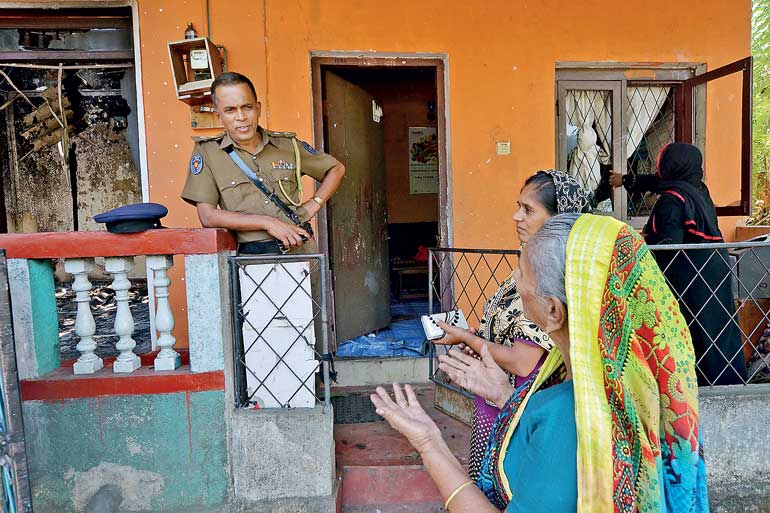Tuesday Mar 04, 2025
Tuesday Mar 04, 2025
Thursday, 22 March 2018 00:00 - - {{hitsCtrl.values.hits}}


Cat’s Eye was deeply saddened to witness another wave of anti-Muslim violence, yet again, under a Government which promised to protect them from such violence.
It was reported that the first round of violence in Ampara was sparked by a claim that a Muslim restaurant was spiking their food with “sterilisation pills”. The claim lent itself to a common paranoid rhetoric that Muslims are attempting to make the Sinhala population infertile.
The invocation of fertility is not new. In 2012, No Limit was accused of serving ‘infertility’ toffees; then other Muslim-owned clothing stores were accused of selling undergarments smeared with chemicals aimed at causing infertility.
These stories were absurd, yet nobody refuted them. They have been freely circulating in the public sphere, and particularly on social media, for far too long. This time, it is laudable that the medical community responded to this incident and denounced the outrageous allegation, debunking the myth that triggered violence against Muslims.
The steps taken by the Police to take the suspected infertility pill from the eatery in Ampara to the Government Analyst, and the ruling of the Government Analyst that this was a “carbohydrate compound” or lump of flour is equally welcome.
The intervention of the medical community and the Government Analyst notwithstanding, we feel a ‘scientific’ explanation alone may not be very helpful to understanding why so many people were so easily persuaded to engage in violence or in preventing such violence in the future due to fears about the potential unproductivity of Sinhala men. This is part of a much broader Sinhala Buddhist ethno-nationalist discourse about Muslim extremism and expansionism that is currently gaining ground in certain sections of the population.
A crude mapping of this rhetoric suggests that it consists of several different myths: a) ‘Muslims do not practice family planning and therefore the Muslim population is growing at a much faster rate and will overtake both the Sinhala and Tamil population’; b) ‘Muslim men are not only entering into inter-racial marriages with Sinhala Buddhist women and forcing them to adopt “foreign” values, leading to the desecration of Sri Lankan culture, they are also forcefully converting and raping Sinhala women’; c) ‘The Government’s family planning programme has primarily targeted Sinhala women, denying them the right to have as many children as they want’.
Concerns about demography reveal a deep-seated fear within the Sinhala majority that the social, political and economic power they hold will be diminished by a ‘rising’ minority population. It is our contention that this nationalist discourse, and its role in defining the Sri Lankan nation state, has to be understood as being fundamentally tied to women’s bodies, dominant notions of masculinity and its relationship to real economic conditions.
The marking, policing and enforcing of boundaries between communities also works to enable the heteronormative policing of women within communities. Implicitly coded within the discourse of women’s reproduction and their role in sustaining a particular ‘race’, is community ownership of women’s bodies, in particular through an emphasis on concerns such as the purity and honour of a community or the family.
The “our women” language stems from communities, families and the State via laws and policies, which all too often violate the rights of these same women by sanctioning cultural and social norms and practices which are harmful to women and girls: domestic and family violence, incest, rape, sexual abuse, limiting access to sexual and reproductive healthcare, and so on. In many of these instances, what communities do to “their women” is permissible by virtue of it being done by “their men”; while in contrast, a perceived threat to the wellbeing of one community’s women by another, such as the threat of the sterilisation pills aimed at Sinhalese by Muslims, is cause for outrage and retaliation.
This feigned concern for the women and girl children of the community is a useful tool with which to mobilise men, by calling upon their masculinity and protector status; a status embedded in the power dynamic of unequal gender relations.
Beyond the glaring ethno-religious “in-group/out-group” ideas at the epicentre of the violence, the real economic motivations and insecurities of the attackers cannot be ignored. The focus on masculine insecurities also brings to the fore the economic insecurities that are shaping relationships between communities at the local level.
The Muslim community has seen attacks on their businesses, whether big commercial enterprises such as Fashion Bug and No Limit or small eateries and restaurants, both as a target of the organised violence, as well as via the circulation of the fertility-related misinformation.
Cat’s Eye sees the increasing cost of living and difficult economic conditions for a majority of the population (of all ethnicities) as being intrinsically linked to the production of a nationalist, racist sentiment against a perceived economically productive minority – something we have seen time and time again in Sri Lankan history.
This sentiment has been allowed to sediment. It is weaved into political discourse, stark in the poor and red-herring responses of the State throughout our recent history, and is most efficiently mobilised by parties with vested interests when expedient.
Thus, anxieties about Muslim procreation and fertility and the extinction of the Sinhala race exists in a mutually reinforcing relationship with biological and cultural notions of men’s roles as progenitors and protectors of the nation and women’s roles as reproducers of the nation.
The examination of the gendered nature of this rhetoric helps us to look beyond the purely ethnic dimensions of the violence towards addressing the economic inequalities that underpin ethnicised violence.
Recognising the complex gendered dimensions of our current predicament can perhaps help us to prevent these recurrent waves of violence in the future. It would mean going beyond a call to the multi-ethnic, multi-cultural notion of Sri Lanka, towards understanding and addressing the factors which drive real tensions and anxieties between communities and people.
(The Cat’s Eye column is written by an independent collective of feminists, offering an alternative feminist gaze on current affairs in Sri Lanka and beyond.)
Discover Kapruka, the leading online shopping platform in Sri Lanka, where you can conveniently send Gifts and Flowers to your loved ones for any event including Valentine ’s Day. Explore a wide range of popular Shopping Categories on Kapruka, including Toys, Groceries, Electronics, Birthday Cakes, Fruits, Chocolates, Flower Bouquets, Clothing, Watches, Lingerie, Gift Sets and Jewellery. Also if you’re interested in selling with Kapruka, Partner Central by Kapruka is the best solution to start with. Moreover, through Kapruka Global Shop, you can also enjoy the convenience of purchasing products from renowned platforms like Amazon and eBay and have them delivered to Sri Lanka.
Discover Kapruka, the leading online shopping platform in Sri Lanka, where you can conveniently send Gifts and Flowers to your loved ones for any event including Valentine ’s Day. Explore a wide range of popular Shopping Categories on Kapruka, including Toys, Groceries, Electronics, Birthday Cakes, Fruits, Chocolates, Flower Bouquets, Clothing, Watches, Lingerie, Gift Sets and Jewellery. Also if you’re interested in selling with Kapruka, Partner Central by Kapruka is the best solution to start with. Moreover, through Kapruka Global Shop, you can also enjoy the convenience of purchasing products from renowned platforms like Amazon and eBay and have them delivered to Sri Lanka.